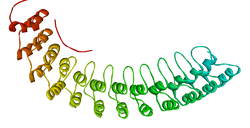Ankyrin – Wikipedia

Ankyrine sind Repeat-Proteine, die wie Antikörper zu den Bindungsproteinen gehören. Ankyrine sind Cytoskelett-Proteine, die über dynamische, nicht-kovalente Bindungen mit integralen Membranproteinen interagieren und deren Verteilung innerhalb der Zellmembran mitbestimmen.
In Erythrozyten bindet Spektrin über Ankyrin an die Zellmembran.[1]
Die hereditäre Sphärozytose basiert in etwa der Hälfte der Fälle auf einer Deletion im Ankyrin-Gen.[2] Plasmodium falciparum bindet an Ankyrin.[3] ANK3 (Ankyrin G) ist möglicherweise an der Entstehung bipolarer Störungen beteiligt.[4]
Literatur
[Bearbeiten | Quelltext bearbeiten]- Peter Michaely, Diana R. Tomchick, Mischa Machius, Richard G.W. Anderson: Crystal structure of a 12 ANK repeat stack from human ankyrinR. In: The EMBO Journal. 21, Nr. 23, 2002, S. 6387–6396, doi:10.1093/emboj/cdf651, PMID 12456646, PMC 136955 (freier Volltext).
- Vann Bennett, Anthony J. Baines: Spectrin and Ankyrin-Based Pathways: Metazoan Inventions for Integrating Cells Into Tissues. In: Physiological Reviews. 81, Nr. 3, 2001, S. 1353–1392, PMID 11427698.
- Patrick A Singleton, Lilly Y. W Bourguignon: CD44 interaction with ankyrin and IP3 receptor in lipid rafts promotes hyaluronan-mediated Ca2+ signaling leading to nitric oxide production and endothelial cell adhesion and proliferation. In: Experimental Cell Research. 295, Nr. 1, 2004, S. 102–118, doi:10.1016/j.yexcr.2003.12.025, PMID 15051494.
Einzelnachweise
[Bearbeiten | Quelltext bearbeiten]- ↑ V. Bennett, P. J. Stenbuck: Identification and partial purification of ankyrin, the high affinity membrane attachment site for human erythrocyte spectrin. In: Journal of Biological Chemistry. 254, Nr. 7, 1979, S. 2533–2541, PMID 372182.
- ↑ Samuel E. Lux u. a.: Hereditary spherocytosis associated with deletion of human erythrocyte ankyrin gene on chromosome 8. In: Nature. 345, Nr. 6277, 1990, S. 736–739., doi:10.1038/345736a0, PMID 2141669.
- ↑ V. Bennett, P. J. Stenbuck: Identification and partial purification of ankyrin, the high affinity membrane attachment site for human erythrocyte spectrin. In: Journal of Biological Chemistry. 254, Nr. 7, 1979, S. 2533–2541, doi:10.1016/j.bbamem.2013.09.014, PMID 372182.
- ↑ Manuel A. R. Ferreira u. a.: Collaborative genome-wide association analysis supports a role for ANK3 and CACNA1C in bipolar disorder. In: Nature Genetics. 40, Nr. 9, 2008, S. 1056–1058, doi:10.1038/ng.209, PMID 18711365, PMC 2703780 (freier Volltext).


 French
French Deutsch
Deutsch